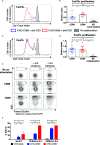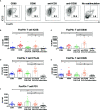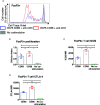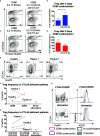CD86 Is a Selective CD28 Ligand Supporting FoxP3+ Regulatory T Cell Homeostasis in the Presence of High Levels of CTLA-4
- PMID: 33363541
- PMCID: PMC7753196
- DOI: 10.3389/fimmu.2020.600000
CD86 Is a Selective CD28 Ligand Supporting FoxP3+ Regulatory T Cell Homeostasis in the Presence of High Levels of CTLA-4
Abstract
CD80 and CD86 are expressed on antigen presenting cells and are required to engage their shared receptor, CD28, for the costimulation of CD4 T cells. It is unclear why two stimulatory ligands with overlapping roles have evolved. CD80 and CD86 also bind the regulatory molecule CTLA-4. We explored the role of CD80 and CD86 in the homeostasis and proliferation of CD4+FoxP3+ regulatory T cells (Treg), which constitutively express high levels of CTLA-4 yet are critically dependent upon CD28 signals. We observed that CD86 was the dominant ligand for Treg proliferation, survival, and maintenance of a regulatory phenotype, with higher expression of CTLA-4, ICOS, and OX40. We also explored whether CD80-CD28 interactions were specifically compromised by CTLA-4 and found that antibody blockade, clinical deficiency of CTLA-4 and CRISPR-Cas9 deletion of CTLA-4 all improved Treg survival following CD80 stimulation. Taken together, our data suggest that CD86 is the dominant costimulatory ligand for Treg homeostasis, despite its lower affinity for CD28, because CD80-CD28 interactions are selectively impaired by the high levels of CTLA-4. These data suggest a cell intrinsic role for CTLA-4 in regulating CD28 costimulation by direct competition for CD80, and indicate that that CD80 and CD86 have discrete roles in CD28 costimulation of CD4 T cells in the presence of high levels of CTLA-4.
Keywords: CD28; CD80; CD86; CTLA-4; costimulation; homeostasis; regulatory T cells.
Copyright © 2020 Halliday, Williams, Kennedy, Waters, Pesenacker, Soskic, Hinze, Hou, Rowshanravan, Janman, Walker and Sansom.
Conflict of interest statement
The authors declare that the research was conducted in the absence of any commercial or financial relationships that could be construed as a potential conflict of interest.
Figures






Similar articles
-
Targeting CD28, CTLA-4 and PD-L1 costimulation differentially controls immune synapses and function of human regulatory and conventional T-cells.PLoS One. 2013 Dec 23;8(12):e83139. doi: 10.1371/journal.pone.0083139. eCollection 2013. PLoS One. 2013. PMID: 24376655 Free PMC article.
-
TCR Signaling and CD28/CTLA-4 Signaling Cooperatively Modulate T Regulatory Cell Homeostasis.J Immunol. 2017 Feb 15;198(4):1503-1511. doi: 10.4049/jimmunol.1601670. Epub 2017 Jan 4. J Immunol. 2017. PMID: 28053234 Free PMC article.
-
CD80 on Human T Cells Is Associated With FoxP3 Expression and Supports Treg Homeostasis.Front Immunol. 2021 Jan 8;11:577655. doi: 10.3389/fimmu.2020.577655. eCollection 2020. Front Immunol. 2021. PMID: 33488578 Free PMC article.
-
Molecular and Cellular Functions of CTLA-4.Adv Exp Med Biol. 2020;1248:7-32. doi: 10.1007/978-981-15-3266-5_2. Adv Exp Med Biol. 2020. PMID: 32185705 Review.
-
Targeting T cell costimulation in autoimmune disease.Expert Opin Ther Targets. 2002 Jun;6(3):275-89. doi: 10.1517/14728222.6.3.275. Expert Opin Ther Targets. 2002. PMID: 12223069 Review.
Cited by
-
Nrf2 Regulates Inflammation by Modulating Dendritic Cell-T Cell Crosstalk during Viral-Bacterial Superinfection.J Immunol. 2024 Dec 15;213(12):1834-1843. doi: 10.4049/jimmunol.2400322. J Immunol. 2024. PMID: 39485002
-
Comparative Analysis of Inhibitory and Activating Immune Checkpoints PD-1, PD-L1, CD28, and CD86 in Non-Melanoma Skin Cancer.Cells. 2024 Sep 18;13(18):1569. doi: 10.3390/cells13181569. Cells. 2024. PMID: 39329753 Free PMC article.
-
Neo-BCV: A Novel Bacterial Liquid Complex Vaccine for Enhancing Dendritic Cell-Mediated Immune Responses Against Lung Cancer.Vaccines (Basel). 2025 Jan 13;13(1):64. doi: 10.3390/vaccines13010064. Vaccines (Basel). 2025. PMID: 39852843 Free PMC article.
-
Microglia in Circumventricular Organs: The Pineal Gland Example.ASN Neuro. 2022 Jan-Dec;14:17590914221135697. doi: 10.1177/17590914221135697. ASN Neuro. 2022. PMID: 36317305 Free PMC article. Review.
-
Impact of CTLA-4 checkpoint antibodies on ligand binding and Transendocytosis.Front Immunol. 2022 Aug 31;13:871802. doi: 10.3389/fimmu.2022.871802. eCollection 2022. Front Immunol. 2022. PMID: 36119113 Free PMC article.
References
Publication types
MeSH terms
Substances
Grants and funding
LinkOut - more resources
Full Text Sources
Other Literature Sources
Research Materials

